
Atlas F1 GP Editor
In what must have been one of the dullest races of the season, the ten Formula One teams yet again failed to reach an agreement for next season on a much needed change to the series. These are the most professional men in motorsport, yet four months since FIA's Max Mosley required them to come up with their own formula, they are still bickering and arguing while the fans turn away from the sport. Do they really know what they're talking about? David Cameron returns from Budapest disappointed
Changes to the series have been clearly necessary for some time, and to that end FIA President Max Mosley announced in April plans for sweeping changes to the make up of the cars that compete in the Formula One Championship, to the dismay of various team bosses up and down the paddock.
Mosley initially pointed to changes that he would make in 2008, at the expiry of the current Concorde Agreement, and then gave the teams an ultimatum - come up with a workable alternative which will significantly slow down the cars in racing trim for the 2005/6 seasons, or he would use Article 7.5 of the Agreement, which allows changes to be enforced unilaterally by the FIA on safety grounds.
Like everything in Formula One, the meetings of the TWG are generally kept confidential; everything is carried out away from the prying eyes of the media and the public, so when the official FIA press conference was held on Friday in Hungary, it was a glimpse into the soul of the entity that is supposed to decide what the future of the sport will be, and it wasn't pleasing to the eye. After the press conference a journalist noted that if you ask one question to six people you will probably get six answers unless they are Formula One people, in which case you will get thirteen. It was a fair summation.
When asked what the forthcoming regulations would compromise of, Ferrari's Ross Brawn stated, matter of fact, that "the diffuser is changed to produce less downforce, the front wing is lifted up, the rear wing is moved forward and there's one set of tyres for the whole race."
Brawn went on to determine that "the aerodynamic regulations are virtually agreed. I'm pretty certain they're the regulations which will go through, because I believe five or six teams have now written to the FIA saying that those are the regulations they want, and therefore there is no other process in place for an alternative set of regulations.
"I think the tyre regulations are in place, because Michelin and Bridgestone have written to the FIA and jointly asked for a solution, which the FIA accepted. I think the only debate as far as I am concerned is the engine regulations, where two teams in particular are objecting to the proposals. But in terms of building a car and knowing how the tyres are going to be run next year, we think it's clear." Renault's Pat Symonds agreed with Brawn, and it seemed that all was running smoothly.
Except that Minardi's Paul Stoddart didn't see it this way at all.
It was shaping up to be yet another in a long list of disagreements between the team bosses and the engineers who provide them with the tools to go racing, and it was an indication of a familiar problem in Formula One - if the engineers, who are hot-wired to compete and defeat each other in their day to day lives, can agree with each other about what is required, then why can't their bosses?
Let's take a look at what the TWG has agreed upon. The amended chassis seems to be okay, with Symonds noting: "I don't think we have any problems. I think this will apply to all teams; it has been under discussion at the TWG for a while, and from it the principles were well established and the detail really didn't cause much discussion. So I don't think there are any problems there."
Brawn agreed and, noting the safety concerns of the FIA, stated: "I think there is a reasonably substantial reduction in downforce that will reduce cornering speeds, and certainly move in a direction of slowing the cars down. So I think it is pretty clear what is going to happen, and on Sunday morning we have a Technical Working Group meeting to just go through some details, I believe they are going through some details, and I think most people now are building their cars for next year."
Naturally enough, Stoddart disagreed, living up to his reputation. "The first thing is that we are not preparing and getting ready to build a new car and there is a simple (reason) for that: we cannot afford to make a wrong choice. Here we are at the Hungaroring, traditionally a bit of a watershed race where people announce drivers, engines and are well advanced on their design and build programmes for the following year, and we haven't got a clue what the regulations are."
Brawn noted that, after Michelin and Bridgestone met and discussed a common goal for the forthcoming season, the issue of tyres was settled, incorporating a reduction of sets of tyres for a race weekend and one set of tyres for both qualifying and the race, as well as the same prime and option specifications for all customer teams. For such a vital component of a Formula One car there was remarkably little argument from Stoddart or Jordan, although Sauber's Willi Rampf, looking uncomfortable at being drawn into discussing concepts usually dealt with behind closed doors, voiced a word of caution.
Getting the tyres specifications right is vital - so much now flows from tyre technology that any error will be fatal to a team's chances in the race. Refueling was brought back into the series in 1994, and it changed the face of modern Formula One, and one set of tyres for qualifying and the race will have an equally radical effect - Symonds noted that "if the qualifying procedure goes in a particular way I can tell you at a race like here in Hungary you would be looking at a one-stop race, and simulations say that you go to lap 49 here. If you can't overtake on this track, and you have only one pitstop that's two thirds of the way through the race. I don't think it is very exciting, and I think we have to be very careful of that."
To take that one step further, if fuel cells can be built to accommodate it, the inability to change tyres could result in races without pitstops – why give away time in the pits if you have to run the whole race on the same tyres? These are potentially very exciting changes to the series, but obviously the car designers need the time to come up with a design that can accommodate these changes, and with nothing yet decided this time is dribbling away.
A word of caution should, however, be noted - Symonds was clear on one particular problem that could arise: "I am very worried that if we do go to the single tyre rule that we will produce a show that I don't think will be as good as the show we have now, and I think that is something we need to be very careful of. People say they want to see overtaking, they want to see a change in the order of the races, and it may not happen so much with a single tyre."
Brawn seemed to think that the chassis and tyre regulations are agreed, or as agreed as they can be right now. "The FIA have said this is a proposal we are prepared to accept because we think it's a good proposal, and unless you can come up with an alternative proposal, which requires eighty percent, then this is the one by default that we are going to apply. So six teams have written to the FIA and said we are going to go along with your proposals. So by definition there can no longer be a majority for an alternative proposal. So as far as we're concerned, it's done."
The six teams mentioned are the six represented in the press conference, and yet if they could disagree as much as they did on Friday, then what chance is there of them convincing Ron Dennis, Frank Williams and the Japanese manufacturers to go along with them, especially when it comes to something as contentious as the format of the engine that will be run?
The current plan, apparently agreed by the group of six, is two fold - for 2005 the existing 3.0 litre V10 engines are to have their life expectancy extended to two race weekends, with a 2.4 litre V8 to replace it the following year. Initially this was to be raced next year, but the lead time necessary was such that the interim step was brought in.
"I think on the engine we are in broad support of the two main proposals," Brawn noted. "It is just the timescale makes it quite expensive to do it. Obviously over a longer timescale it would have been a little bit more economic, but I think the 2.4 V8 is necessary to reduce the speeds of the cars, and I think the two-race engine ultimately will make it more economic for the teams with smaller budgets to operate so we need to support it."
It's clear to see why the six teams supported the proposition - Ferrari have enjoyed engine superiority for some time, and extending the life of the engine should be no problem for them, or their customer Sauber. Renault have a noted power deficit, so they aren't going to lose much, while Cosworth are already used to extending the life of their engines via their deal with Minardi.
More ominously Burkhard Goeschel, main board director at BMW, has stated: "we are committed to motorsports, (but) it's not a question of Formula One. If Formula One is going another way which is not congruent to our ideas and values as BMW, then we would change to another kind of motorsport. We want to race in the top league, that's the only question. If it is attractive and interesting for us we will stay in Formula One. But if it is not, then we won't do it."
Perhaps Brawn is right when he says that six out ten means there can be no chance of an alternative eighty percent agreement, but if one or more of the others drop out of the sport then where does that leave their agreement? Or, as Mosley pointed out about the team principals' meetings when he announced his short lived retirement earlier this year: "people often agree things and then they go away after the meeting and change their minds completely, and that means you've wasted a day." What is to stop one or more of the six changing their minds and flopping over to the other side?
Unfortunately one issue that the TWG can't address, one that is of vital importance to the design of the cars but it outside of their remit as it falls under the sporting regulations rather than the technical, is the question of qualifying. The common perception in the paddock is that the current format isn't working, and an alternative format has been put forward by Jaguar's Tony Purnell, which involves two mini races worked out with a lottery draw for the grid, with the results being aggregated to form the grid for the main race.
But the major issue for the TWG is to know what kind of a qualifying format they are gearing their new car designs for, so they can agree on the regulations. As Symonds noted: "it's all very well saying let's get the technical regulations sorted and then we can get on and design our cars, but that is not actually the case. The sporting regulations will always have an influence on car design and, very specifically, the qualifying regulations will and, being even more specific, whether or not you start the race with the fuel you qualified with. It really has a fundamental bearing on how you approach the strategy of the race and, hence, the simple design parameter of how big you want your fuel tank."
Right now there are more questions than answers, and as Jordan repeated endlessly: "It is just preposterous to think that a set of rules and regulations for next year's Championship are not clear and defined at this moment in time."
Purnell made a defining comment about the nature of decision making, between the TWG and the team principals, in Formula One when he said: "I was thinking of the comment that it is too democratic, but really it's more like the communists with their committees. You know committees never decide anything, and what we really want is a dictator, but a benevolent one, that we vote in every three years or something, because that is how practical democracies work. Any democracy which works like the team principals' meetings will be doomed to failure."
To the unfamiliar, Formula One may seem like a dictatorship presided over by Bernie Ecclestone, but the Briton is principally involved in exploitation of the commercial rights of the sport. That he has done a spectacularly good job within his remit is self evident, but comparisons that have been drawn between him and, say, the France family in NASCAR are very wide of the mark.
In NASCAR, the regulations are handed down from on high, after a brief period of consultation with the participants, and are then written in stone and unarguable. Unfortunately there is no single person responsible for this aspect of Formula One, and over the years this had led to more disruption in the sport than any other area.
Letting the teams decide how to run the series is a ridiculous situation – self interest rules the day every time, and agreement is accordingly almost impossible to achieve. Mosley, for his part, recognised this and has tried to rectify the situation by pushing through his ideas under the only avenue available to him – the safety clause of the Concorde Agreement. Whether it will work is not yet clear – it is one thing to have, allegedly, six teams agreeing to a change of the regulations, but all it will take is for McLaren or Williams to fundamentally disagree and attempt a legal challenge on these changes actually being for safety and the whole house of cards could collapse on itself.
At the end of Sunday all of the major players left immediately after the processional race, and I managed to catch Symonds as he was leaving for the airport. When I asked him if the TWG had signed off on any of the regulations he said no, not yet. "So for all of the emotions and floral language of the press conference nothing is changed, nothing is resolved?" I asked.
All he could do was nod and smile, embarrassed, as he walked towards the car park.
The race weekend in Hungary was proof, if any was needed, that the current crop of team bosses have lost track of what is needed to run a racing series, a seemingly simple process that is at risk of getting lost amongst recrimination and self interest while the future of the sport is uncertain, and the current season was encapsulated by the snorefest shown on television sets worldwide.
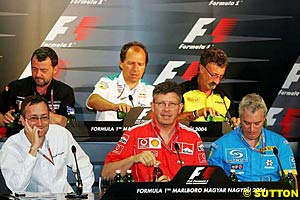 The Technical Working Group (TWG) - comprising the Technical Directors of each team - has had four months to come up with a workable alternative to Mosley's recommendations, and in those four months they have agreed upon precisely nothing. And, when you consider the inevitable debates the team principals will run though before signing off on a new agreement for the chassis, engine, tyre and qualifying requirements necessary to race next season, the delay looks farcical. The potential of these changes is incredible, but they need to be made as soon as possible to allow the teams to dream up the cars that will carry the immediate future of the sport.
The Technical Working Group (TWG) - comprising the Technical Directors of each team - has had four months to come up with a workable alternative to Mosley's recommendations, and in those four months they have agreed upon precisely nothing. And, when you consider the inevitable debates the team principals will run though before signing off on a new agreement for the chassis, engine, tyre and qualifying requirements necessary to race next season, the delay looks farcical. The potential of these changes is incredible, but they need to be made as soon as possible to allow the teams to dream up the cars that will carry the immediate future of the sport.
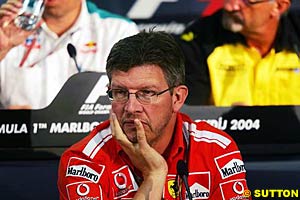 "Now wait," he interjected. "It has not been agreed. Ross is saying five or six teams - it requires eight votes in the technical working group to get it through, and that's the problem we have time and time again." Eddie Jordan weighed in, noting that he was completely unaware that six teams had agreed to the full set of regulation changes, and agreeing with Stoddart that, as ever, the stumbling block was going to be the team principals agreeing to the changes. And they should know.
"Now wait," he interjected. "It has not been agreed. Ross is saying five or six teams - it requires eight votes in the technical working group to get it through, and that's the problem we have time and time again." Eddie Jordan weighed in, noting that he was completely unaware that six teams had agreed to the full set of regulation changes, and agreeing with Stoddart that, as ever, the stumbling block was going to be the team principals agreeing to the changes. And they should know.
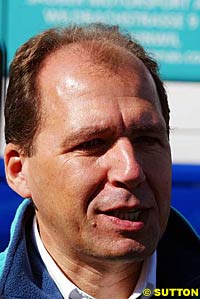 "On the tyre side," Rampf said, "we don't exactly know what the tyre regulation will look like, but if the tyre regulation does change the strategy for next year - say one and two stops instead of three stops - this would obsolete the different chassis concepts, and when we are in the design phase fuel cell volume is something you cannot change during a season. So we have to make a best guess what is the fuel cell volume for next year."
"On the tyre side," Rampf said, "we don't exactly know what the tyre regulation will look like, but if the tyre regulation does change the strategy for next year - say one and two stops instead of three stops - this would obsolete the different chassis concepts, and when we are in the design phase fuel cell volume is something you cannot change during a season. So we have to make a best guess what is the fuel cell volume for next year."
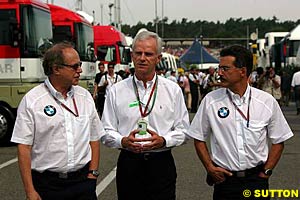 What isn't clear is how they are planning to convince the other suppliers to go along with the plan. BMW's motorsport director Mario Theissen has already given his thoughts on the matter: "what I can say is that we're questioning the change to a two-race engine format for next year, because that would require a design change and would mean you have to drop some of the work already done. If we went to a two-race engine format now, everybody will have to rush to get something done for next year. You couldn't do a reasonable job - so I would expect more engine blow ups."
What isn't clear is how they are planning to convince the other suppliers to go along with the plan. BMW's motorsport director Mario Theissen has already given his thoughts on the matter: "what I can say is that we're questioning the change to a two-race engine format for next year, because that would require a design change and would mean you have to drop some of the work already done. If we went to a two-race engine format now, everybody will have to rush to get something done for next year. You couldn't do a reasonable job - so I would expect more engine blow ups."
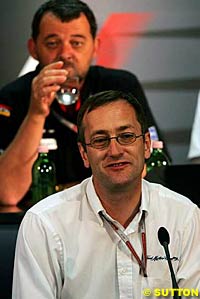 This proposal seems overly complicated, and certainly difficult for the fans at home to work out, as well as having ramifications on engine and tyre life – a far more simple alternative would be to run one session on a Saturday, in reverse order of the results from the previous race, so that potentially each lap is quicker than the previous and takes provisional pole, generating interest throughout the hour.
This proposal seems overly complicated, and certainly difficult for the fans at home to work out, as well as having ramifications on engine and tyre life – a far more simple alternative would be to run one session on a Saturday, in reverse order of the results from the previous race, so that potentially each lap is quicker than the previous and takes provisional pole, generating interest throughout the hour.
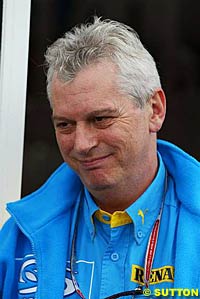 But where does that leave the current mess? Pat Symonds noted that "our problem of today, I believe, is pretty well there. I am quite sure the technical working group will effectively ratify these proposals on Sunday, and I'm sure that there will then be further argument, but strictly speaking, once that's done, those are the rules. Now, I know that perhaps that's an idealistic view and that there are certain team principals who have a lot of say, a lot of influence and they can turn things round, but we're doing everything we can to resolve this situation, and think we're behaving responsibly and professionally."
But where does that leave the current mess? Pat Symonds noted that "our problem of today, I believe, is pretty well there. I am quite sure the technical working group will effectively ratify these proposals on Sunday, and I'm sure that there will then be further argument, but strictly speaking, once that's done, those are the rules. Now, I know that perhaps that's an idealistic view and that there are certain team principals who have a lot of say, a lot of influence and they can turn things round, but we're doing everything we can to resolve this situation, and think we're behaving responsibly and professionally."
|
Contact the Author Contact the Editor |
Please Contact Us for permission to republish this or any other material from Atlas F1.
|
Volume 10, Issue 33
Articles
Formula What?
Bjorn Wirdheim: Going Places
Ann Bradshaw: Point of View
2004 Hungarian GP Review
2004 Hungarian GP Review
Technical Review: Hungary 2004
The Business of Winning
Stats Center
Qualifying Differentials
SuperStats
Charts Center
Columns
The F1 Insider
Season Strokes
On the Road
Elsewhere in Racing
The Weekly Grapevine
> Homepage |